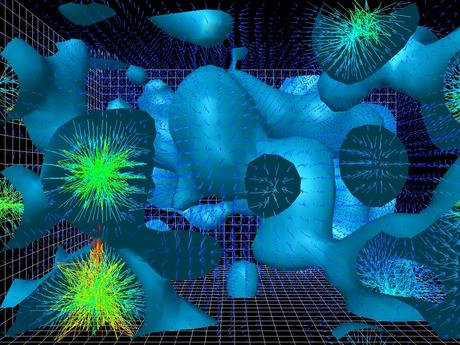As he approaches the end of his remarkable life, physicist-novelist Alan Lightman is engaged in the time-honored tradition of making sense of it all. He attempts to do so, at least in part, in this essay on “nothingness.” While there is nothing novel about his exploration of the issue, or the personal conclusions he has reached, this early part of the essay is worth further consideration:
My first experience with Nothingness in the material world of science occurred when I was a graduate student in theoretical physics at the California Institute of Technology. In my second year, I took a formidable course with the title of Quantum Field Theory, which explained how all of space is filled up with “energy fields,” usually called just “fields” by physicists. There is a field for gravity and a field for electricity and magnetism, and so on.
What we regard as physical “matter” is the excitation of the underlying fields. A key point is that according to the laws of quantum physics, all of these fields are constantly jittering a bit—it is an impossibility for a field to be completely dormant—and the jittering causes subatomic particles like electrons and their antiparticles, called positrons, to appear for a brief moment and then disappear again, even when there is no persistent matter.
Physicists call a region of space with the lowest possible amount of energy in it the “vacuum.” But the vacuum cannot be free of fields. The fields necessarily permeate all space. And because they are constantly jittering, they are constantly producing matter and energy, at least for brief periods of time. Thus the “vacuum” in modern physics is not the void of the ancient Greeks. The void does not exist.
Every cubic centimeter of space in the universe, no matter how empty it seems, is actually a chaotic circus of fluctuating fields and particles flickering in and out of existence on the subatomic scale. Thus, at the material level, there is no such thing as Nothingness.
Let’s recapitulate the key points: All space is filled with energy fields. Matter is dependent on the excitation of the fields. Fields constantly produce matter and energy. There is no void but instead constant activity. Fluctuating fields cause particles to flicker in and out of existence.
These are the facts of physics, not matters of speculative philosophy. Here is another fact: we have no idea how all this activity affects humans or how much of it humans can sense. It is also a fact that humans are embodied in space; we are thus subject to fields. I have long suspected that much of what is culturally constructed as “supernatural” or “spiritual” or “religious” is a product of these fields, which humans perceive only partially and imperfectly. I also suspect that a few or several hundred years from now, people will look back at our time and judge us as being more or less ignorant. Using a centuries long measuring stick, today’s knowledge makes us tomorrow’s primitives.
Postscript — As some readers may have noticed, I’ve not been posting with my usual regularity over the past few weeks. This is because during my happy camping sojourns over the summer, I’ve contracted West Nile virus, about which we know very little and for which there is no treatment. Science is indeed in its infancy. Once time has worked its wonderful magic, I will resume a more regular posting schedule.

Vacuum Gluon Field of Quantum Chromodynamics (Derek B. Leinwber, Physics Dept, Adelaide University)

